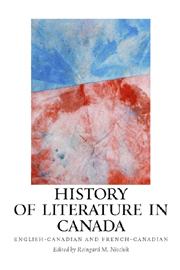Book contents
- Frontmatter
- Contents
- Acknowledgments
- Introduction: Writing a History of Literature in Canada
- I Beginnings
- II The Literature of New France, 1604–1760
- III The Literature of British Canada, 1763–1867
- IV From the Dominion to the Territorial Completion of the Nation, 1867–1918
- V The Modern Period, 1918–1967
- VI Literature from 1967 to the Present
- Further Reading
- Notes on the Contributors
- Index
Introduction: Writing a History of Literature in Canada
Published online by Cambridge University Press: 12 September 2012
- Frontmatter
- Contents
- Acknowledgments
- Introduction: Writing a History of Literature in Canada
- I Beginnings
- II The Literature of New France, 1604–1760
- III The Literature of British Canada, 1763–1867
- IV From the Dominion to the Territorial Completion of the Nation, 1867–1918
- V The Modern Period, 1918–1967
- VI Literature from 1967 to the Present
- Further Reading
- Notes on the Contributors
- Index
Summary
“Canadian” has been broadly used for whatever is native, or has been naturalized, or has a distinct bearing on the native — that is, on people, events, and writings which had their focus in our “environment,” as Northrop Frye has put it…. That which is distinctly Canadian-French in language, thought, culture, and literary production has been left, in accord with their own wishes, to the French scholars of Québec. The time will come, one may hope, when it will be possible to have a French series of books paralleling our English ones — and translations in each of the languages — to facilitate a much-needed comparative study.
Carl F. Klinck, introduction, volume 3 of Literary History of Canada (2nd ed., 1976)Even if we assume smooth relations on the political level … another generation will probably pass before we see a healthy and mutual interchange between the two literatures. At the present time, Englishand French-Canadian writing are best discussed separately.
William Keith, introduction, Canadian Literature in English (1985)The Project in Brief
LITERATURE IN CANADA, particularly the booming cultural production from the 1960s onwards, has arrived at the center stage of world literature. Books by English-Canadian authors today make regular appearances on international bestseller lists, both through established writers such as Margaret Atwood (1939–) and Michael Ondaatje (1943–) and through new talents such as Yann Martel (1963–) and Madeleine Thien (1974–).
- Type
- Chapter
- Information
- History of Literature in CanadaEnglish-Canadian and French-Canadian, pp. 1 - 24Publisher: Boydell & BrewerPrint publication year: 2008



